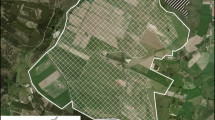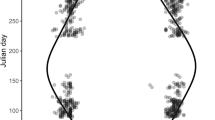Abstract
During the spring migration, the Pink-footed Goose Anser brachyrhynchus stops in mid-Norway to refuel before continuing its flight to the Svalbard breeding grounds. While in mid-Norway the geese feed on pasture, stubble and newly sown grain fields. Here, we describe the diurnal variation in goose behaviour at a staging site and assess the extent to which behavioural patterns are attributable to physiological factors (digestibility of the food) and environmental conditions (flock size, type and frequency of disturbance and distance to roost). We found that feeding activity peaked at mid-day, whereas the birds were most alert in the morning and afternoon. The behaviour of Pink-footed Goose also varied with habitat type, disturbance level and distance to roost. The diurnal variation in feeding activity differed from behaviour reported for geese on the wintering grounds, indicating that the birds have different energetic and nutrient demands when at spring staging sites. Seasonal changes in habitat availability as well as density dependence may also affect the birds’ behavioural patterns. A sporadic, unpredictable disturbance reduced the proportion of geese feeding to a greater extent than a predictable, recurrent disturbance, but feeding activity was highest under undisturbed conditions.
Zusammenfassung
Veränderungen im Verhalten von Kurzschnabelgänsen ( Anser brachyrhynchus ) im Tagesverlauf während ihrer Frühlingsrast in Trøndelag, Norwegen
Während des Frühjahrszuges rasten Kurzschnabelgänse in Mittelnorwegen, um vor ihrem Weiterflug in die Brutgebiete in Spitzbergen nochmals Nahrung aufzunehmen. In Mittelnorwegen fressen diese Gänse auf Weideland, Stoppelfeldern und frischer Getreidesaat. Diese Untersuchung beschreibt die tageszeitlichen Veränderungen im Verhalten der Gänse an einem Rastplatz und beurteilt, inwieweit Verhaltensmuster mit physiologischen Faktoren (Verdaubarkeit des Futters) und Umweltbedingungen (Gruppengröße, Art und Häufigkeit von Störungen und Entfernung vom Schlafplatz) in Verbindung gebracht werden können. Die Futteraufnahme hatte ihren Höhepunkt um Mittag, während die Vögel am Morgen und Nachmittag am wachsamsten waren. Das Verhalten der Kurzschnabelgänse unterschied sich auch in Abhängigkeit von Habitat, Ausmaß von Störungen und der Entfernung vom Schlafplatz. Die tageszeitlichen Veränderungen in der Nahrungsaufnahme unterschieden sich von denen, die über Gänse im Winterquartier berichtet wurden, was darauf hindeutet, dass die Vögel während ihrer Frühjahrsrast unterschiedliche energetische und Nährstoff-Anforderungen haben. Auch saisonale Veränderungen in der Habitatverfügbarkeit und Dichteabhängigkeit könnten die Verhaltensmuster der Vögel beeinflussen. Sporadische, unvorhersehbare Störungen verringerten den Anteil an fressenden Gänsen in stärkerem Maße als vorhersagbare, wiederkehrende Störungen, aber die Fraßaktivität war am höchsten unter ungestörten Bedingungen.






Similar content being viewed by others
References
Alerstam T, Lindström Å (1990) Optimal bird migration: the relative importance of time, energy, and safety. In: Gwinner E (ed) Bird migration. Springer, Berlin, pp 331–351
Altmann J (1974) Observational study of behaviour: sampling methods. Behaviour 49:227–267
Anderson D, Burnham KP, Thompson WL (2000) Null hypothesis testing: problems, prevalence and an alternative. J Wildl Manage 64(4):912–923
Bauer S, Madsen J, Klaassen M (2006) Intake rate, stochasticity, or onset of spring—what aspects of food availability affect spring migration patterns in pink-footed geese Anser brachyrhynchus? Ardea 94(3):555–566
Bauer S, Dinther MV, Høgda K-A, Klaasen M, Madsen J (2008) The consequences of climate-driven stop-over sites changes on migration schedules and fitness of Arctic geese. J Anim Ecol 77:654–660
Crawley M (2007) The R book. Wiley, London
Demment MW, Soest PJV (1985) A nutritional explanation for body size patterns of ruminant and nonruminant herbivores. Am Nat 125:641–672
Drent R, Both C, Green M, Madsen J, Piersma T (2003) Pay-offs and penalties of competing migratory schedules. Oikos 103:274–292
Duriez O, Bauer S, Destin A, Madsen J, Nolet BA, Stillman RA, Klaassen M (2009) What decision rules might pink-footed geese use to depart on migration? An individual-based model. Behav Ecol 20:560–569
Environmental Systems Research Institute (ESRI) (2010) ArcGIS 10.0. Environmental Systems Research Institute, Redlands. Available at: http://www.esri.com
Fox AD, Madsen J, Boyd H, Kuijken E, Norriss DW, Tombre IM, Stroud DA (2005) Effects of agricultural change on abundance, fitness components and distribution of two arctic-nesting goose populations. Glob Change Biol 11:881–893
Fox AD, Cao L, Barter M, Rees E, Hearn R, Cong PH, Wang X, Zhang Y, Dou ST, Shao XF (2008a) The functional use of East Dongting Lake, China, by wintering geese. Wildfowl 58:3–19
Fox AD, Hearn RD, Cao L, Cong PH, Wang X, Zhang Y, Dou ST, Shao XF, Barter M, Rees EC (2008b) Preliminary observations of diurnal feeding patterns of Swan Geese Anser cygnoides using two different habitats at Shengjin Lake, Anhui Province, China. Wildfowl 58:20–30
Hedenström A (2008) Adaptations to migration in birds: behavioural strategies, morphology and scaling effects. Phil Trans R Soc B 363:287–299
Inglis I, Lazarus J (1981) Vigilance and flock size in Brent geese: the edge effect. Ethology 57(3–4):193–200
Karasov WH (1990) Digestion in birds: chemical and physiological determinants and ecological implications. Stud Avian Biol 13:391–415
Klaassen M, Bauer S, Madsen J, Tombre I (2006) Modelling behavioural and fitness consequences of disturbance for geese along their spring flyway. J Appl Ecol 49:92–100
Kvist A, Lindström Å (2000) Maximum daily energy intake: it takes time to lift the metabolic ceiling. Physiol Biochem Zool 73(1):30–36
Ladin Z, Castelli PM, McWilliams SR, Williams CK (2011) Time energy budgets and food use of Atlantic Brant across their wintering range. J Wildl Manage 75(2):273–282
Madsen J (1985) Relations between change in spring habitat selection and daily energetics of pink-footed geese Anser brachyrhynchus. Ornis Scand 16:222–228
Madsen J (1994) Impacts on disturbance on migratory waterfowl. IBIS 137:S67–S74
Madsen J, Hansen F, Kristensen JB, Boyd H (1997) Spring migration strategies and stopover ecology of pink-footed geese. Results of field work in Norway, 1996. NERI technical report no. 204. National Environmental Research Institute, Roskilde
Madsen J, Cracknell G, Fox T (1999) Goose population of the Western Palearctic. Wetlands international publication no. 48. National Environmental Research Institute, Denmark
Madsen J, Tombre I, Eide NE (2009) Effects of disturbance on geese in Svalbard: implications for regulating increasing tourism. Polar Res 28:376–389
McDonald P, Edwards RA, Greenhalgh JFD (1973) Animal nutrition. Oliver & Boyd, Edinburgh
Owen M (1972) Some factors affecting food intake and selection in white-fronted geese. J Anim Ecol 41:79–92
Prop J, Vulink T (1992) Digestion by barnacle geese in the annual cycle: the interplay between retention time and food quality. Funct Ecol 6(2):180–189
Prop J, Black JM, Shimmings P (2003) Travel schedules to the high arctic: barnacle geese trade-off the timing of migration with accumulation of fat deposits. Oikos 103:403–414
R Development Core Team (2011) R: a language and environment for statistical computing, 2.13.1 edn. R Foundation for Statistical Computing, Vienna
Rees E, Bruce JH, White GT (2005) Factors affecting the behavioural responses of whooper swans (Cygnus c. cygnus) to various human activities. Biol Conserv 121:369–382
Schielzeth H (2010) Simple means to improve the interpretability of regression coefficients. Methods Ecol Evol 1:103–113
Therkildsen OR, Madsen J (2000a) Assessment of food intake rates in pink-footed geese Anser brachyrhynchus based on examination of oesophagus contents. Wildl Biol 6(3):167–172
Therkildsen OR, Madsen J (2000b) Energetics of feeding on winter wheat versus pasture grasses: a window of opportunity for winter range expansion in the pink-footed goose Anser brachyrhynchus. Wildl Biol 6(2):65–74
Tombre IM, Madsen J, Tømmervik H, Haugen K-P, Eythórsson E (2005) Influence of organised scaring on distribution and habitat choice of geese on pastures in Northern Norway. Agric Ecosyst Environ 111:311–320
Acknowledgments
This study was part of M.C.’s PhD project funded by Aarhus University. The fieldwork was supported by the Norwegian Research Council project MIGRAPOP. We would like to thank Per Ivar Nicolaisen and Flemming Hansen for help during the data collection. We also thank Eileen Rees and an anonymous reviewer for valuable comments on the manuscript. All field methods used in this study comply with the current laws of the country in which they were performed.
Author information
Authors and Affiliations
Corresponding author
Additional information
Communicated by F. Bairlein.
Rights and permissions
About this article
Cite this article
Chudzinska, M., Madsen, J. & Nabe-Nielsen, J. Diurnal variation in the behaviour of the Pink-footed Goose (Anser brachyrhynchus) during the spring stopover in Trøndelag, Norway. J Ornithol 154, 645–654 (2013). https://doi.org/10.1007/s10336-012-0927-y
Received:
Revised:
Accepted:
Published:
Issue Date:
DOI: https://doi.org/10.1007/s10336-012-0927-y




